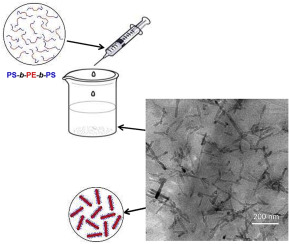Polymer ( IF 4.6 ) Pub Date : 2017-09-04 , DOI: 10.1016/j.polymer.2017.09.002 Sen Xu , Chongyin Zhang , Lei Li , Sixun Zheng

|
In this work, we reported the synthesis of a series of novel semicrystalline ABA triblock copolymers with polyethylene midblock and polystyrene endblocks via the combination of ring-opening metathesis polymerization (ROMP), hydrogenation and reversible addition-fragmentation chain transfer (RAFT) polymerization. First, an α,ω-dihydroxyl-terminated polycyclooctadiene (PCOD) was synthesized via the ROMP of cyclooctadiene by the use of the Grubbs second generation catalyst and with cis-2-butene-1,4-diol as the chain transfer agent. The α,ω-dihydroxyl-terminated PCOD was then hydrogenated into an α,ω-dihydroxyl-terminated polyethylene (PE); the latter was allowed to react with 2-methyl-2-[(dodecylsulfanylthiocarbonyl) sulfanyl]propanoic acid to afford a macromolecular chain transfer agent (i.e., Macro-CTA) for the RAFT polymerization of styrene. By controlling the lengths of PS endblocks, a series of polystyrene-block-polyethylene-block-polystyrene (PS-b-PE-b-PS) triblock copolymers were obtained. The successful synthesis of the ABA triblock copolymers were demonstrated by means of nuclear magnetic resonance (NMR) spectroscopy and gel permeation chromatography (GPC). The results of differential scanning calorimetry (DSC) and atomic force microscopy (AFM) indicate that the PS-b-PE-b-PS triblock copolymers were microphase-separated in bulks and their morphologies were quite dependent on the mass ratios of PE to PS blocks. Transmission electron microscopy (TEM), atomic force microscopy (AFM) and dynamic light scattering (DLS) showed that the triblock copolymers displayed crystallization-driven self-assembly (CDSA) behavior in selective solvent (viz. 1,4-dioxane). Depending on the lengths of PS blocks, the CDSA behavior of all the triblock copolymers generated spherical and cylindrical micelles. It was found that the quantity of the cylindrical micelles increased with decreasing the lengths of PS blocks.
中文翻译:

聚苯乙烯-嵌段-polyethylene-嵌段-聚苯乙烯三嵌段共聚物的合成和结晶驱动自组装行为
在这项工作中,我们报告了通过开环易位聚合(ROMP),氢化和可逆加成-断裂链转移(RAFT)聚合的组合,合成了一系列具有聚乙烯中嵌段和聚苯乙烯端嵌段的新型半结晶ABA三嵌段共聚物。首先,使用格鲁布斯第二代催化剂和顺式反应,通过环辛二烯的ROMP合成了一个α,ω-二羟基封端的聚环辛二烯(PCOD)。-2-丁烯-1,4-二醇作为链转移剂。然后将α,ω-二羟基封端的PCOD氢化成α,ω-二羟基封端的聚乙烯(PE);使后者与2-甲基-2-[(十二烷基硫烷基硫代羰基硫烷基)硫烷基]丙酸反应,得到用于苯乙烯的RAFT聚合的大分子链转移剂(即, Macro-CTA)。通过控制PS端嵌段的长度,可以得到一系列的聚苯乙烯嵌段-聚乙烯嵌段-聚苯乙烯(PS- b -PE- b得到-PS)三嵌段共聚物。通过核磁共振(NMR)光谱和凝胶渗透色谱(GPC)证明了ABA三嵌段共聚物的成功合成。差示扫描量热法(DSC)和原子力显微镜(AFM)的结果表明,PS- b -PE- b -PS三嵌段共聚物是微相分离的,其形态在很大程度上取决于PE与PS的质量比。块。透射电子显微镜(TEM),原子力显微镜(AFM)和动态光散射(DLS)表明,三嵌段共聚物在选择性溶剂中表现出结晶驱动的自组装(CDSA)行为(即。1,4-二恶烷)。取决于PS嵌段的长度,所有三嵌段共聚物的CDSA行为都会产生球形和圆柱形胶束。已经发现,随着PS嵌段的长度减小,圆柱状胶束的数量增加。



























 京公网安备 11010802027423号
京公网安备 11010802027423号